My son is learning about integers at school. It is quite a challenging topic to come to, especially as, thus far, for him, trying to understand it purely based on the familiar is both a necessity and a tough challenge due to the novelty of the idea.
First off, it is not a big deal if kids are unable to grasp integers initially. They eventually do, but given that integers weren’t “natural” enough to be invented for millennia1, it is perfectly normal to not understand them from the get go. Coming up with negative numbers is like inventing a new piece of mind technology.
Still, the problem remains -
How do you explain the principles of integer arithmetic to a young mind? In particular, what would constitute an explanation of the rule
M - (-N) = M + N?
Constraints
The challenge in coming up with an explanation is that there are some constraints to meet.
- You can assume knowledge of normal addition and subtraction.
- You cannot assume algebraic thinking yet. So you have to explain why
6-(-3) = 6+3 = 9without resorting to rules about moving numbers across the=sign. - Doing it purely based on rules isn’t satisfactory as an explanation because it isn’t rooted in our senses for us to recall and draw analogies with other things we encounter with less effort.
- Analogies work as explanations, but we should strive for perfect analogies - i.e. analogies based on which we can discover principles in either domain and translate it into the other without exceptions. Such analogies, in mathematical jargon, are called isomorphisms.
So, what isomorphisms might be useful as explanations for why 6 - (-3) = 9?
Physical analogies
Brahmagupta (598 AD - 670 AD) apparently used the terminology of fortune and debt to label positive and negative numbers when he articulated the rules of calculation with them.2 From that, we have -
“A debt subtracted from zero is a fortune.”
In other words, if you take away the debt that someone owes someone, you’ve essentially given them a fortune. This is understandable because if you give someone a fortune, you know they can clear their debts with it. So giving someone a fortune has the same effect as taking away their debts. This is similar to the system used in China to keep track of spending.
While it is an ingenious step to generalize debt and fortune in this way, I’m not satisfied with this as a way to understand integers - the negative kind - for several reasons -
- The notion of debt is usually between two people, as in “Ramu owes Kumar”, whereas the notion of fortune is more commonly absolute.3
- One debt isn’t quite exchangeable for another, but fortune is easier thought of as exchangeable. If Ramu owes Kumar, and Kumar owes Rahim, Kumar cannot usually tell Rahim to get it from Ram. This holds unless a central agency (like a government) intervenes and declares these debts to be equivalent … and we have money. But the question remains - how is it that getting “negative money” from someone is the same as giving them money?
Much like the way physicists originally thought of anti-particles as the absence of particles from an infinite invisible sea, physical analogies like this … kind of suck. I was never satisfied with the particle/anti-particle pair creation myth that the anti-particle is like the empty hole in a sea of energy that the particle got separated from, or however it is stated. It doesn’t work for me because I’m not sure that way of explanation is useful in any other way - i.e. it isn’t a perfect analogy.
I attempted another one in the same spirit nevertheless, using a bowl of dense yoghurt - or “curd” in South India. If you scoop out some curd from the bowl, leaving behind some empty space, it amounts to subtraction. If we instead describe that same activity as “adding a scoop of empty space to the bowl of curd”, we’re beginning to approach the notion of negative numbers. So how do you then “take away a scoop of empty space in the bowl”? You do that by adding an equivalent scoop of curd back in.

Yes. That’s tasty, but sucks as an explanation because now I have to explain why a “scoop of empty space” in the context of a bowl of curd is not the same as a “scoop of empty space” in the context of a bowl of cream cheese.
The good ol' number line
Counting on the number line is a useful device for understanding numbers.
However, trying to demonstrate the calculation of 6 - (-3) is a vexing
exercise, at least without some basic understanding already in place. You can
do 6 - 3 as “move 6 steps to the right and move 3 steps to the left”, but
what would be “move -3 steps to the left” and why would that be the same as
“move 3 steps to the right”?
It is possible to “explain” using rules again, but that, as noted earlier, is not acceptable, since it doesn’t meet the criterion of familiarity.
Number line with arrows

This is a variation on the number line, but with the additional introduction of arrows. The number “3”, for example, is expected to be looked upon as an arrow with its tail at 0 and its head at 3. You can shift these arrows about, but you got to start somewhere.

To add two such numbers, you shift the arrow of the second number such that its tail coincides with the head of the first number.
Addition = head to tail connection
Similarly, to subtract two numbers, you place the head of the second arrow such that it coincides with the head of the first arrow.
Subtraction = head to head connection
In the above picture, you see 3 and 4 making 7. It shows both the addition
and subtraction rules as pointed out in the pictures below.


Now, what if we try to add an arrow that is pointing leftward? From the picture
below, we can see that it is effectively the same as subtraction, and serves to
illustrate 7 - 4 = 7 + (-4), where -4 is represented by a left facing arrow
of length 4. We’re adding -4 since we attached the tail of the left
pointing arrow to the head of the 7 arrow.

Now that we’ve established -4 as a left pointing arrow of length 4, we can
subtract -4 from 7 by aligning -4’s head with the head of 7. From the
below picture, we see that we land at 11 at the end.

It is now easy to see that if we simply flip the direction of the -4 arrow,
we will continue to remain at 11, and now the picture is a description of the
addition of 7 and 4 to get 11. This is how we show the equivalence of 7 - (-4) and 7 + 4.

Egocentric movement
This one is by far the most satisfactory one for me. The mapping goes as follows -
- You stand facing a certain arbitrarily chosen direction.
- “Adding a number”, for example, “adding 3”, corresponds to taking “3 steps forward”.
- “Subtracting 3” corresponds to taking “3 steps backwards”.
With this much, you can do regular arithmetic. If you’re keeping track of numbers on the number line in the direction you’re looking, you can somewhat understand already that there are positions before where you began and you can label them with negative numbers. However, that is not yet it.
- You can have “adding -3” be the act of making an about turn and taking “3 steps forward”. This way, we stick to adding being the same as forward movement, which then forces us to make an about turn.
Now, it is easy to see how 7 - 4 is “take 7 steps forward and 4 steps
backward” and how you reach 3 at the end. You can also see that if you take
“7 steps forward” following by an about turn and “4 steps forward”, you still
reach 3. So this serves to illustrate 7 - 4 = 7 + (-4).
How about 7 - (-4)? So you take “7 steps forward”, “make an about turn” and
take “4 steps backward”. You’re subtracting, so you have to walk backward, and
you’re dealing with -4, so you need to make the about turn. Quite easy to see
how you end up at 11 now, which would’ve happened if you took “7 steps forward”
followed by “4 steps forward”. So that’s the analog of 7 - (-4) = 7 + 4 = 11.
This is a perfect analogy to both meanings of the symbol - used -
- The
-in-4is mapped to the about turn, and - the
-in subtraction is mapped to “walk backwards”.
So the entire problem of explaining this seems to hinge on creating mappings
for these two meanings of -.
The egocentric movement is a close analog of the line number and arrows approach above, but is rooted in our bodily experience instead of an external construct.
Clock face arithmetic
If we give up the need to deal with arbitrarily large numbers, there is something interesting we can do with clock faces that illustrates the concepts of negative numbers and subtraction while working only with positive numbers and addition. Now, that’s interesting because it can introduce the concept while staying within the confines of what is already well understood. So we’ll put aside the loss of the infinite and look at the finite for the moment. While this “explanation” is rather long, it has the benefit that this domain can be exhaustively explored.
So here is the clock face with numbers counting from 0 to 11 in the … clockwise direction.
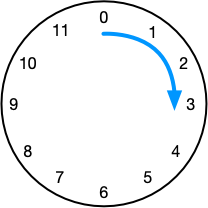
There is nothing special about “clockwise”, so we’ll also number the points in the opposite “anti-clockwise” direction too.
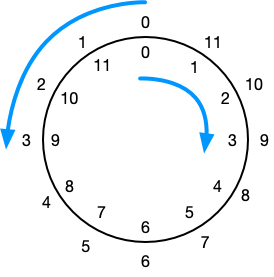
The interesting thing to note about the numbering is that the pairs of numbers on the opposite sides of the clock circle add up to 12 .. but not quite, because 12 is the same as 0 on the clock face. So we can say that these pairs of numbers add up to 0. They are also symmetric, in that if you take the “outside number” corresponding to the “inside number” 5, you get 7, and if you take the “inside number 7” and find its “outside number”, you’ll get 5. Geometrically, if you take the mirror image of the above double-numbered clock face and then exchange the inside and outside numbers, you’ll get back the original clock face.
Now let’s try to do some normal arithmetic. 3 + 4 = 7 is an easy one.
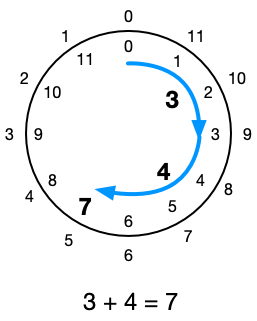
So is 7 - 4 = 3, which we can visualize as -
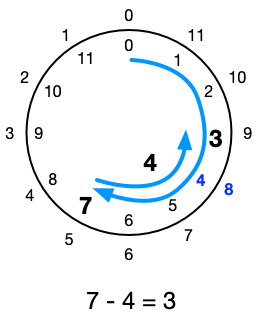
Eek - we’re moving in the anti-clockwise direction inside the clock and we don’t want to deal with subtraction. So how do we get to 3 without subtracting? We notice that on the clock face, we can add 8 to 7 and get to 3. In fact, to find out which number you got to add in order to have the same effect as subtracting it, you just pick the outside number corresponding to that number. In this case, the outside number corresponding to 4 on the inside is indeed 8.
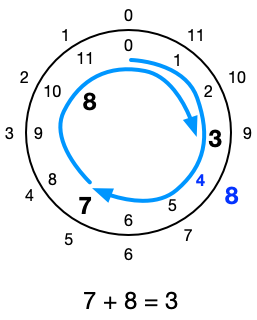
So we have 7 - 4 = 3 = 7 + 8 in the clock face world. With that
understanding, we can say that -4 is a synonym for +8 … which goes for
every inside-outside pair of numbers. i.e. 7 - 4 = 7 + (-4) = 7 + 8 = 3.
So how would we do 7 - (-4)? We know -4 is a synonym for 8, so this must
be the same as 7 - 8, which brings us to 11 on the inside. But, but … we
can go one step further and say 7 - 8 = 7 + (-8) = 7 + 4 = 11, since the
outside number of 8 is 4. So we have 7 - (-4) = 7 + 4. In words, this
equation is saying “adding two numbers on the inside of the clock face is the
same as subtracting the outside number of the second number from the first
inside number”.
The finiteness is not so much of a limitation when working with practical
numbers, because you can pick any large enough number of divisions on the clock
face. For example, if you want to find out 21 - (-16), you can imagine a
clock face with 100 divisions. So the outside number of 16 on that clock face
would be 84, so you have 21 - 84, which you know is 21 + (-84) and the
outside number of 84 is .. 16, so you have to just calculate 21 + 16. You
still need to be careful about the ordering of numbers in the general case
though, so that when asked to calculate 16 - 21, you don’t answer 16 - 21 = 16 + (-21) = 16 + 79 = 95, but then you go and use the synonym of 95 and state
it as -5. So 16 - 21 = -5.
Yes. Agreed. Modulo arithmetic is probably complicated to teach when just introducing integers. But then again, I think kids should be introduced to modulo arithmetic first instead because we encounter more instances of that, right from the use of the place value system. The clock face approach can make for some great free play though since it can be exhaustively explored.
Phew!
Of the above, my personal favourite is the egocentric movement analogy due to its ease of mental execution, followed by the number line + arrows representation. The clock face arithmetic is loads of exploratory fun though.
It is no surprise that the concept of negative numbers eluded our best minds of many millennia and continued to make more recent bright minds uncomfortable about it. No wonder complex numbers had a tougher history, but we’ll deal with that when we come to it!
Footnotes
-
History of integers notes that the British mathematician Francis Maseres claimed that negative numbers "… darken the very whole doctrines of the equations and make dark of the things which are in their nature excessively obvious and simple". ↩︎
-
Again, from History of integers. ↩︎
-
One person may consider a 100 cows to be a fortune but another may not. ↩︎
- Notations
- Tala Keeper
- Demos
- Talks
GitHub · Twitter · Google+ · LinkedIn · RSS